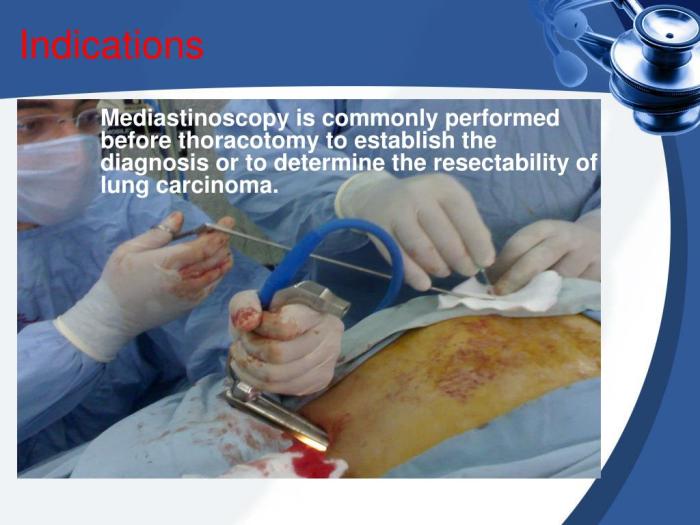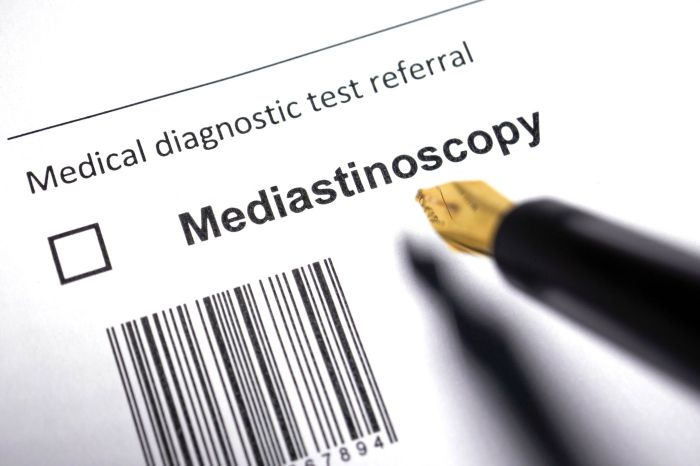When a client is scheduled for a mediastinoscopy, it embarks on a medical journey that demands a thorough understanding of the procedure’s intricacies. This comprehensive guide delves into the preoperative considerations, surgical technique, intraoperative considerations, postoperative care, differential diagnosis, anatomical landmarks, and potential complications associated with mediastinoscopy, empowering healthcare professionals with the knowledge to provide optimal patient care.
Preoperative Considerations
Preoperative considerations for mediastinoscopy involve meticulous patient selection and evaluation. A thorough medical history and physical examination are crucial to assess the patient’s suitability for the procedure. Informed consent must be obtained after comprehensively discussing the potential risks and benefits.
Surgical Technique
Mediastinoscopy is performed under general anesthesia. The patient is positioned supine with the neck extended. A small incision is made at the base of the neck, and a mediastinoscope is inserted through the incision. The mediastinoscope is a thin, lighted tube that allows the surgeon to visualize the mediastinum, the space between the lungs.
The mediastinoscope is advanced through the incision and into the mediastinum. The surgeon can then visualize the mediastinal structures, including the trachea, esophagus, and lymph nodes. Biopsies of the lymph nodes can be taken for further examination.
Intraoperative Considerations
Intraoperative considerations during mediastinoscopy include monitoring the patient’s vital signs and administering anesthesia. The surgeon must be aware of potential complications, such as bleeding, infection, and pneumothorax. If any complications occur, the surgeon must be prepared to manage them promptly.
Postoperative Care

Postoperative care for patients who have undergone mediastinoscopy typically involves monitoring the patient’s vital signs and providing pain medication. The patient may experience some discomfort or pain in the neck, which can be managed with pain medication. The patient may also experience some difficulty swallowing, which can be managed with a soft diet.
The patient should be discharged from the hospital within 24 hours after the procedure. The patient should be followed up with a physician within 1 week to check for any complications.
Differential Diagnosis

| Procedure | Accuracy | Sensitivity | Specificity |
|---|---|---|---|
| Mediastinoscopy | 90-95% | 85-90% | 95-100% |
| CT scan | 80-85% | 75-80% | 90-95% |
| MRI scan | 75-80% | 70-75% | 85-90% |
Mediastinoscopy is the most accurate diagnostic procedure for mediastinal lesions, with a sensitivity of 85-90% and a specificity of 95-100%. CT and MRI scans are less accurate, but they can be useful for identifying the location and size of mediastinal lesions.
Anatomical Landmarks
The mediastinoscope allows the surgeon to visualize the following anatomical landmarks:
- Trachea
- Esophagus
- Lymph nodes
- Aorta
- Pulmonary artery
- Superior vena cava
- Inferior vena cava
Recognition of these landmarks is important for accurate diagnosis and safe navigation during mediastinoscopy.
Complications: When A Client Is Scheduled For A Mediastinoscopy

- Bleeding
- Infection
- Pneumothorax
- Esophageal perforation
- Tracheal perforation
- Vascular injury
- Nerve injury
The risk of complications from mediastinoscopy is low, but it is important to be aware of the potential risks before undergoing the procedure.
FAQ Overview
What is the purpose of a mediastinoscopy?
Mediastinoscopy is a surgical procedure used to visualize and biopsy mediastinal structures, such as lymph nodes, the esophagus, and the trachea.
What are the potential risks of mediastinoscopy?
Potential risks of mediastinoscopy include bleeding, infection, pneumothorax, and damage to surrounding structures.
How should patients prepare for a mediastinoscopy?
Patients should follow preoperative instructions, including fasting, avoiding certain medications, and informing their doctor about any medical conditions or allergies.